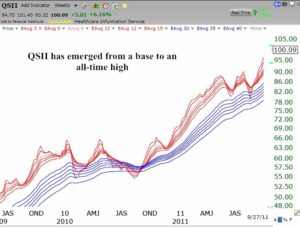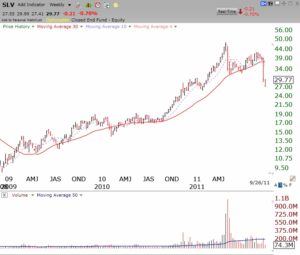The QQQ appears unable to break above key averages. A close below 54 would be very ominous for me. Wednesday was the 15th day of the current QQQ short term up-trend, within a longer term down-trend.
 Dr. Wish
Dr. Wish
QQQ short term up-trend continues; QSII break-out
The market continues to recover, with the T2108 well into neutral territory. It remains to be seen whether the market can break through its longer term averages. Meanwhile, the GMMA monthly chart below shows that QSII has emerged from a multi-month base. Judy and I have been talking about QSII for some time, and I currently own some of QSII. (Click on chart to enlarge.) With the GMI at 1, I remain very cautious.
13th day of QQQ short term up-trend; SLV entering Stage IV decline?
The QQQ short term up-trend survived on Monday. I am holding on to a few small long positions……
A reader asked me to plot SLV like I did GLD yesterday. SLV tracks silver. The chart for SLV is much more negative than the one for GLD. Note the huge down volume from the peak and the break below the 30 week average (red line). Silver may be entering a Stage IV decline. Click on chart to enlarge.

